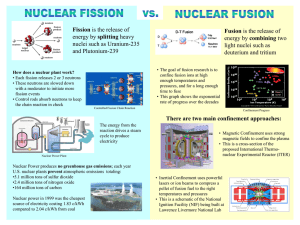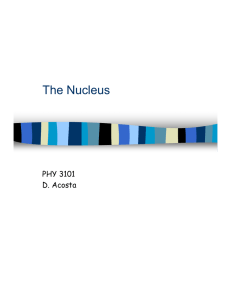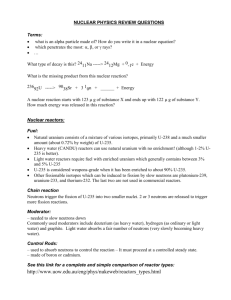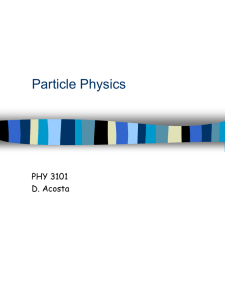Nuclear Reactions PHY 3101 D. Acosta
advertisement
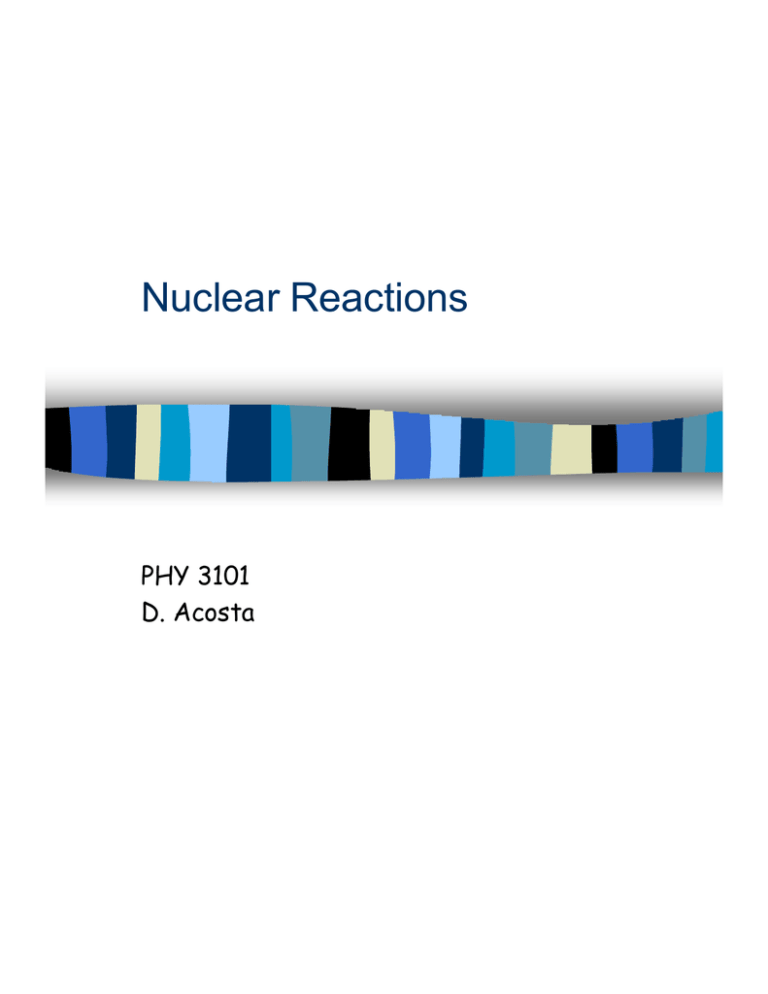
Nuclear Reactions PHY 3101 D. Acosta Nuclear Alchemy n First nuclear reaction performed by Rutherford in 1919 using α-particles: 4 14 1 17 2 He + 7 N→1 H + 8 O n Reaction Energy: a f a f Q = M initial products − M final products × c 2 n Exothermic: energy released in reaction Endothermic: energy absorbed in reaction – Goes into mass n Nuclear reactions take place in atmosphere: n 1 14 1 14 0 n+ 7 N →1 H + 6 C – Carbon binds to form CO 2 which is absorbed by plants and animals n Carbon-14 dating: – 14C is continually replenished until the plant or animal dies – 14C decays, and amount left gives age – t1/2 = 5730 years 4/13/2001 PHY 3101 -- D. Acosta 2 Nuclear Fission n Enrico Fermi and Italian groups bombard nuclei with neutrons to produce new isotopes: 1 A A +1 0 n + Z X→ Z X n In 1938, Hahn and Strassman in Germany split uranium Frisch and Lise Meitner call it fission (like cell division) and observe that excess energy is shed (exothermic) Excess neutrons are released which may catalyze more reactions Niels Bohr points out that 235U (0.7% natural abundance) is more likely than 238U (99.3%) to fission because of odd number of neutrons – Need to use enriched uranium Many possible fission fragments are possible For example: 99 134 n+ 235 92 U → 40 Zr + 52Te + 3n Energy released is: n Average number of neutrons released is 2.3 n n n n n n 1.0087u + 235.04u – 98.92u –133.91u –3(1.0087u) = 0.2u ⇒ 185 MeV 4/13/2001 PHY 3101 -- D. Acosta 3 Nuclear Fission n n n n n n n Uranium is on the downward slope of the binding energy per nucleon curve More energetically favorable for Uranium to split into smaller nuclei More neutrons are released than incident If the released neutrons are absorbed, this starts a chain reaction Critical Mass: – Larger mass sustains chain reaction – Smaller mass implies neutrons escape – Critical mass is a few kg for uranium Controlled fission: moderators slow and absorb neutrons More efficient fission from plutonium, which can be produced by bombarding 238U with neutrons to get 239Pu – Average of 2.7 neutrons per Pu fission – t1/2 = 24,000 years 4/13/2001 PHY 3101 -- D. Acosta 4 Atomic Bomb n Suppose 1 kg of enriched 235U fissions: Q= 185 MeV 1 kg 1u 32 × × = 4 . 7 × 10 eV fission 235 u 1.66 × 10 -27 kg Q = 7.6 × 1013 J = 18 kT (1 kT of TNT = 4.2 × 1012 J = 1012 calories) n Large as this is, it is still small compared to the total rest mass energy: a fd E = mc = 1 kg 3 × 10 m / s 2 8 i 2 E = 9 × 1016 J = 21400 kT = 21.4 MT n Only 1/1000 of energy released in fission 4/13/2001 PHY 3101 -- D. Acosta 5 Nuclear Fusion n n Dividing high Z elements librates energy, but so does fusing low Z elements (upward part of binding energy per nucleon curve) Consider the fusion of deuterium and hydrogen (powers the Sun and H-bomb) 2 1 H +11H→ 23 He + γ Q = 2.0141u +1.00783u - 3.01603u × c 2 Q = 0.0059 uc 2 = 5.5 MeV 4/13/2001 PHY 3101 -- D. Acosta 6 Solar Reactions n The “burning” of hydrogen into helium and higher Z materials in stars: H.A.Bethe n PPI cycle: 1 1 2 + H + H → H + β +νe 1 1 1 2 1 3 H+ H → 1 1 2 He + γ 3 3 4 1 1 He+ He → He+ H+ 2 2 2 1 1H n Q = 1.44 MeV Q = 5.5 MeV Q = 12.9 MeV PPII cycle: 3 4 7 He+ He → 2 2 4 Be + γ β - + 74 Be→ 73 Li + ν e 1 7 4 4 H+ Li → He+ 1 3 2 2 He n PPIII cycle: 1 7 8 H + Be → 1 4 5B + γ 8 8 + B → Be + β +νe 5 4 8 4 4 Be → He + 4 2 2 He 4/13/2001 PHY 3101 -- D. Acosta 7 Stars n n n n n Fusion of higher Z elements occurs when lower Z fuel is exhausted Continues until 56Fe is produced, which is at the peak of the binding energy vs. Z curve – Not energetically favorable to fuse higher Z nuclei Without energy source, star collapses and may explode as a supernova All elements in the periodic table besides H and He are produced (and released) by stars in the universe Direct evidence for solar fusion is available because we have detected the neutrinos released in the solar reactions 4/13/2001 PHY 3101 -- D. Acosta 8
